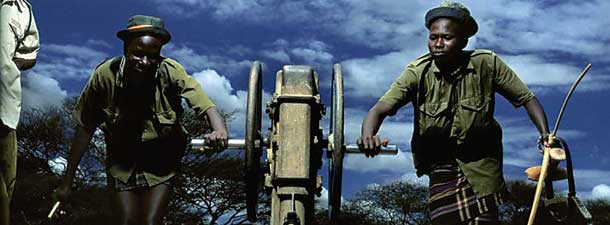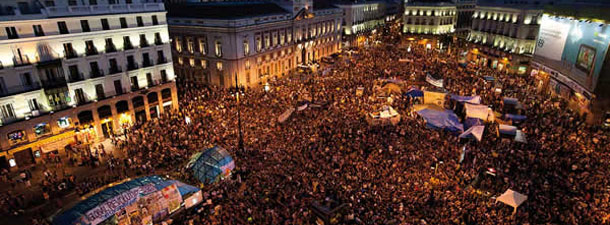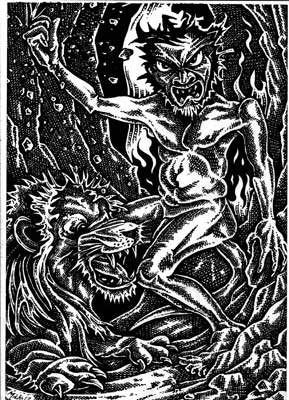
Nonno Panda and the Killer Whale
July 1, 2012
Why Photography Matters As Art As Never Before
July 1, 2012The Age of Protest: World Revolution in the Making?

Madrid Spain - Indignados Puerta del Sol
It is difficult to see the shape of an age while living inside it, experiencing it as it plays itself out. The turmoil of our own times seems fragmented, frantic, chaotic, and at times senseless. But while outcomes can only be known after (sometimes long after) the fact, it is possible, by taking a longer historical view, to discern the heart and soul of the times. We may be removed chronologically from the birth of the age of revolution that began the Enlightenment. But those revolutions have been in process ever since – resurging and retrenching – and are still unrolling before us, in all their terror and glory, in the events of our day.

Madrid Spain – Indignados Puerta del Sol
C
The crackle of the musketry of colonial American Minutemen on New Hampshire’s Concord Green in 1776 was described as the “shot heard round the world.” The unthinkable had happened. The thirteen colonies of the putative United States had dared to stand against the might of the British Empire in their bid for independence.
Farmers and townsmen took on the mightiest professional military force of the day and – though it was a near-run thing – wrested their freedom from it. The modern age of revolution had begun. Fuelled by the ideas of the Enlightment, the spirit of revolution carried over to France in 1789. It was a trans-Atlantic phenomenon with the liberal ideas of both Old and New Worlds coming together in emboldened synthesis to storm the ramparts of absolutist rule. Arguably, the seed of this new revolutionary foundation had been erected culturally and emotively centuries before during the Renaissance, with its resurrection of a humanistic spirit. The insurgent bayonets and secularist printing presses of the late eightenteenth century went further and dared to shape new societies, to recast humanity and its governance anew under universal concepts of freedom and social justice.

Tel-Aviv – Israel
People protesting in the street
These eighteenth century milestones enshrined much of what we regard today as the inalienable values and guarantees of contemporary democratic societies. These are defined by freely elected, representative government that upholds and protects civil rights, human rights, universal emancipation, free expression and the impartial, transparent rule of law. Both the American and French Revolutions in turn fired the passions of Latin American liberators who fought to free the Americas from the Spanish colonial yoke during the nineteenth century. As the Americas cast off foreign colonial power, the die was cast for future anti-colonial struggles across the globe in the twentieth century, in the wake of the Second World War, from Indonesia to Vietnam, Algeria to Angola. The right to insurrectional resistance by subject peoples was firmly established when armies still carried flintlocks.

Bangkok – Thailand
Nationalist People’s Alliance for Democracy
Of course, it wasn’t all an uninterrupted march to utopia. At the conclusion of the Napoleonic Wars, the restoration of the Bourbon monarchy in France and the retrenchment of the status quo of the British, Austro-Hungarian and Russian Empires, together with the consolidation of a unified Prussianled Germany and a European quid pro quo towards the ailing Ottoman Empire, brought a concerted effort to quash the next wave of revolutionary fervour. The attempted revolutions of 1848 were ruthlessly crushed throughout Europe. Thus there ensued a century of peace on the European continent which endured until irrevocably shattered in the flames and industrial carnage of the First World War. The gore of the trenches swallowed up the genteel façade and romanticism of the Belle Époque in hitherto unprecedented slaughter.
The meat grinder of the Great War at last saw the dominance of a privileged European aristocracy wane – an aristocracy that had resisted the writing on the wall since 1789. As noblemen died in the mud of the Great War, the rival armies – by sheer necessity – replaced much of their traditional officer corps with new frontline leaders from the middle and working classes. It was a case of charnel-house upward mobility (save in the ranks of the late-coming US military, where middle class leadership was, and still is, the norm). It brooked a significant change when these same officers returned home; they had to be reckoned with as new social equals, based on meritocracy and not bloodline and nepotistic privilege. Nowhere was the shock and class rupture more brutal than in Russia with the advent of the Bolshevik Revolution that targeted not merely the landed oligarchy but the industrial one too.

People march against the government’s austerity cuts
Rome – Italy
Insurgent Mexico’s agrarian revolution of 1910 had preceded those ten fateful days of Russia’s Red October. It is often overlooked as the first great revolution of the last century, although its cry for “Land and Freedom” was echoed in the short-lived Spanish Republic, which was so efficiently murdered by Franco’s Fascist legions. Martyred Mexican Revolutionary General Emiliano Zapata’s immortal adage “It is better to die on your feet than to live on your knees” was quite literally appropriated by Dolores Ibarurri, “La Passionaria”, the vanquished republic’s most ardently militant voice on the airwaves. Revolution has a way of crossing boundaries, not least in the heart and intellect.
The examples of Mexico and Spain together with the Russian and Chinese Revolutions would, for better and worse, help inspire the next generation of rebels and freedom fighters – and a new, more pernicious form of insurgent, the terrorist – across the breadth of Latin America, the Middle East, Africa and Southeast Asia in the latter half of the twentieth century. There, of course, were other examples, too. Mahatma Gandhi’s long, non-violent struggle to bring down the Raj and end the subjugation of the Indian subcontinent stands as the masterpiece of successful revolutionary struggle that did not embrace the gun. It inspired millions – from Selma Alabama, to the streets of Soweto, to Tiananmen and Tahrir Squares both.

Occupy Wall Street
We know, of course, the disastrous and unequal victors’ peace of Versailles in 1919 all but made the most catastrophic war ever known to humanity virtually inevitable. It provided all the grievances – which the Great Depression compounded – that allowed the rise of the Axis powers. Where today’s troubled Middle East is concerned the future seeds of contemporary dysfunction were also sown in the Hall of Mirrors. The Sykes-Picot treaty between Number 10 Downing Street and the Elysee Palace gnawed all the choice bones of the collapsed Ottoman Empire. It redrew the map of the Middle East into French and British colonies or protectorates with little respect for traditional indigenous cultural, ethnic, tribal, religious, geographic or power structures. Many of the current fragile sectarian fault lines in the region are the direct consequence of this flawed imperial legacy. British-administered Iraq, that empowered a Sunni minority to rule over a predominantly Shia population, is one notable case in point.

Protesters
Trinidad Bolivia
Just as the First World War had not proven to be the “war to end all wars”, neither did Allied victory in the Second bring about a more peaceful or secure world. The Cold War began to run hot not long after Allied and Soviet armies celebrated their joint triumph, with shots fired in anger between American paratroopers and Soviet soldiers in the streets of Berlin in 1945. The Yalta and Potsdam conferences had nonetheless divided the world into Soviet and Western spheres of influence, and so ensued decades of proxy wars between the two rivals that began in the rubble of the German capital. Twice there were narrow escapes from the insanity of “mutual assured destruction” or MAD, both during the Cuban Missile Crisis and in the closing stages of the 1973 Middle East War. But there had been many proxy wars, some overt, some clandestine, most of them rather bloody, where many legitimate struggles for self-determination became ideological and physical pawns in a larger superpower chess game. The Hungarian Uprising. The Prague Spring. The catalogue of Arab-Israeli wars. A host of counter-insurgencies and Dirty Wars in Latin America. Vietnam. Angola, Mozambique, Namibia, Rhodesia, Apartheid South Africa. The list is extensive.

Indignados Israel
At the height of this drawn-out confrontation successive waves of revolutionary fervour seemed to sweep the world, somehow never more vividly than in 1968. That pivotal year saw anti-war sentiment swell in the US.
Students took to the streets and were massacred in Tlatelolco in Mexico City. They battled French police in the streets of Paris and faced Soviet tanks in Czechoslovakia. The Civil Rights movement in the United States was also at its peak and the assassinations of Martin Luther King Jr. and Robert Kennedy seemed to deepen the outrage.
From Berkley to London images of Che Guevara and Ho Chi Minh adorned university dorm rooms. Revolution was in the air, tangibly so, and in its most radicalised form. Within a few short years, Western Europe would see the rise of nihilistic groups like the West German Red Army Faction and the Italian Red Brigades. They expressed solidarity with the Irish Republican Army and the Palestine Liberation Organization, as each of those groups escalated their own armed struggles – one of which we now remember as the “Troubles,” and the other we still contend with in the successive waves of the Intifada.

Borsa de Barcelona
But the clash of titans was coming to an end. When the vaunted Soviet Army marched out of Afghanistan in defeat, it was only logical that the Berlin Wall would soon crumble. And that it did, in the historical blink of an eye, linking the Russian exit from the Hindu Kush to the final hurrah of Soviet hegemony and the Warsaw Pact. But the decline and subsequent collapse of Soviet Communism did not bring about the New World Order that a triumphant Washington had trumpeted. At any rate it did not bring about peace and security (if that was what was even meant by the words). New menaces loomed which have continued to metamorphise to this day.

May Day workers’ march.
Berlin Germany
What has ensued since? War in former Yugoslavia that brought the worst pogrom witnessed in Europe since the end of the Second World War in a place called Srebrenica.
The Rwandan Genocide. Near Genocides in Chechnya, Somalia, Sudan, Northern Iraq. More than four million dead in the Congo and counting. An endless conflict in the Hindu Kush once more. A litany of wars in the Middle East from the Iranian-Iraqi conflict, to two Gulf Wars, to the most recent Lebanese-Israeli confrontation, to the current Syrian uprising. If we include full-scale military conflicts, ongoing insurgencies and rebellions and de facto states of near-civil war such as Mexico’s fight against its own narco-cartels, then we approach a figure of some forty contemporary armed conflicts currently underway across the globe. The world is still at war it just looks nothing like the previous two generalized global conflagrations. And where is the engine of revolution now? It is all around us in virtually every permutation possible from insurrectional violence, to non-violent resistance and civil disobedience, to the cyber activism that has replaced Thomas Paine’s printing press in the internet age. Neither is it solely a positive phenomenon, for all that there are benevolent forces at play. Counterrevolution is also in our midst and there are also would-be revolutions whose vision of the future is a regression to our darkest past. If there is an expressed desire to return to 1776, then it is also in 1933 where hopes for a new Fascism lurk. Even more regressive are those who would seek to return our value systems to a medieval morality. The playing field is much wider and the stakes are much larger. The advent of instant mass communication has brought about an egalitarianism of information gathering and dissemination that Paine and the other seminal pamphleteers of his age – or for that matter Goebbels – could not have begun to imagine.

Durban – Sud Africa.
Climate change protesters
The Arab Spring of 2010 very clearly served as an organisational, inspirational and mobilisation model for the birth of the Occupy Wall Street protests in 2011. The Occupy movement gathered momentum and spread across borders literally circling the globe. That the Arab World, so often seen as hostile, incomprehensible, dangerous, and judged culturally and morally incompatible with the West, would rally so many Americans and Europeans to demand reform must rate as one of the greatest cross-cultural historical phenomena ever. In the Middle East the uprising is a cry for political freedom, a demand that authoritarian Arab regimes from the Maghreb to the Persian Gulf to finally, finally deliver democracy, prosperity and freedom from fear – promises gone unfulfilled since the colonial era ended. OWS is an urgent plea for socioeconomic reform from the so-called 99% of Americans that feel disenfranchised by a moneyed political and business class that has for too long monopolised wealth and the manner in which it is distributed. The Arab Spring, while mostly non-violent, has also embraced the rifle where it has been deemed necessary. The Occupy movement has retained a peaceful strategy.

Protesters in Zurich
In both cases it is a profound call for change of the status quo, a defiant challenge to and rejection of the accepted order of things, nothing less than a revolution in the making. In the Middle East, it is a tale told in blood, especially in Syria, where the bloodiest page of the uprising is being written. And the bloodshed continues unchecked by a hapless international community (i.e., the West, the UN and the Arab League). And as Al Assad’s brutality is abetted by Iran, and the international community is deliberately and cynically hampered by Russia and China, serving their own geopolitical interests, the danger of a sectarian backlash and radicalisation grows. Taken as a whole, the Arab Spring has also been a rebuke of Islamic fundamentalism. Al Qaida, as one strain of a virulent Islamist radicalism, has mostly been left sidelined and mute by the uprising, unable to present itself as a viable alternative nor as a champion of the Arab and Muslim dispossessed, a self-styled role it has sought for itself since its inception. It has now seen an opening in Syria, though its presence is small. Yet will it remain neglible? And as the conflict spills over into Lebanon, will it resist the opportunity to foment Sunni on Shia chaos as it so persistently has done in Iraq?

Protesters in London
The prominence of the Muslim Brotherhood, as a more acceptable vein of Islamic conservatism seeking greater legitimacy in Egypt’s mainstream political process comes as an unpleasant surprise to secularists, the Christian minority and most of all to the millions of women who have stood in the forefront of Egypt’s ongoing revolution since the advent of Tahrir Square, all hoping for a more inclusive, open and fair nation. Can the predominantly Muslim Middle East redefine itself in a tangible way as a region that is at once democratic, egalitarian, Islamic and emancipated for men and women, Muslims and non-Muslims, the devout and the secularists? It remains to be seen. The Arab Spring is messy, uncertain, and fragile for all the momentum it musters. It is a still-evolving experiment, not remotely assured of enduring success or lasting revolutionary change, despite its victories in toppling a number of fierce, longstanding dictatorships. It could still fare poorly, crushed by violence from the ancien regimes that refuse to capitulate or to reform the rot of entrenched corruption and indifferent autocracy that still define so much of the Arab reality. Or it all could just degenerate into multiple civil wars that collide with one another, creating even larger, more intractable conflicts.
Back on Wall Street, is it truly possible for a broad, populist coalition to bring palpable structural and procedural reform to a financial system that is not only virtually sacrosanct to the American way of business and governance, but also is so deeply entrenched in the collusion between corporate power, political interests and the very law of the land, that reform would mean the undoing of America as we know it? How could such reform possibly succeed? Time will tell here too. But it’s salutary to remember that there hasn’t been such a profound change (should it come about) or indeed division in American society since the Civil War in 1861.

Communist Party demo.
Moscow – Russia
Let us then consider the forces of darkness. Across the whole of Europe there is a quiet revolution, growing louder, that sees the ongoing legitimization and increasing power of extremist political parties in the main current of national politics from France to the Baltic, to the Balkans (yet again). They expound xenophobic, authoritarian, racist, hyper-nationalist and clearly undemocratic philosophies that must be decried as neo-Fascist. They too have mastered multimedia and grasped the power of television and the internet, just as the most primitive Taleban propagandist rallies the faithful or strikes fear by posting videos of suicide bombings, the execution of infidels and the ranting diatribes of their angry mullahs. The most strident extremist of any stripe or persuasion one would care to name across the planet has an audience too. If Islamic fundamentalism has lost a great deal of ground in the Middle East, it seems clear the next great opportunity for this malevolent presence is Sub-Saharan Africa, where long disenfranchised, impoverished and angry Muslim populations coincide with a vast territory almost custom made for guerrilla warfare. Largely inept, dysfunctional, corrupt states are unable to effectively confront them or to provide a better alternative for their people. Islamic extremism remains a potent revolutionary force in Africa that has not begun to reach its full potential, even if Al Qaida is otherwise a muchdiminished actor. It is of course always a fallacy to regard Al Qaida as a centralised structure when it is, by definition, a decentralised entity, more of an ideological franchise than an organisation at all. Another revolution of our time is the struggle with the almost-unseen enemy, the non-state actor, the transnational terrorist. No more demanding form of warfare exists. Indeed a military response is only the smallest part of the equation, when the truest battle is fought in the mind and the soul of the radicalised insurgent and his would be adherents.

Portuguese protesters
But there is light and reason as well in the mere hope for revolutionary change. It musters high technology as much as it does the humble demonstration, boycott or strike. It avails itself of multiple forms of advocacy available to a multitude of activists, whether the insurgency is armed or not. Across the planet from the Amazon to Beijing, Wall Street to the polar ice cap, Gaza to Moscow, the status quo is being challenged at every level and in every aspect of society. If there is one cliché that speaks to our age is that business as usual will no longer be tolerated.
Nuclear power, after Chernobyl and Fukushima, is no longer a sacred cow. Climate change, the destruction of the natural environment, and the loss of the irreplaceable are all being contested. Cultural survival is another rallying cry of our times, not just from extremist xenophobes but a host of indigenous peoples throughout the globe who now refuse to go gently into the darkness of extinction. Much in this new era of upheaval has already been fought for in the past. The global revolutionary impulse still strives to bring about liberation in all of its implications, from the most organic issues of free speech, sexual and racial equality, the rights of minorities, freedom of worship, sexual orientation, and cultural identity to the more complex questions of good governance, the legitimate right to nationhood of distinct peoples lacking their own independent state, the manner in which wealth is generated and distributed, the powers and limitations of the nation-state and society at large, and the measures both may impose on the individual and the collective (including the death penalty). These are all part and parcel of the unfinished revolution. There are more recently developing topics, like the ethical treatment of animals, the imposition of punishment for ecological crimes, and the banning of the most barbarous weaponry from landmines, to chemical, bacteriological and nuclear arms. And there remain the age-old evils of tyranny, slavery and extra-judicial violence. Genocide and crimes against humanity are with us still. The concepts of international accountability and international law – making it stick that is – are still a revolution in the making, more than a half century after Nuremberg.

Occupy Wall Street
NYC
The revolution is here and is as multi-faceted and complex as our age, but its final course is uncharted. Much is opaque, indiscernible, undetermined. We can guess as to the final outcome but we won’t know until we know. We can’t ignore it either. We are forced to live in it and will bear its consequences. The salient question then is whether to remain a passive spectator or to choose a side and become engaged in it more deeply, to empower ourselves as actors in the looming change, participants who strike to effect that very change or face being pushed aside. Aux Barricades, Citoyens!



